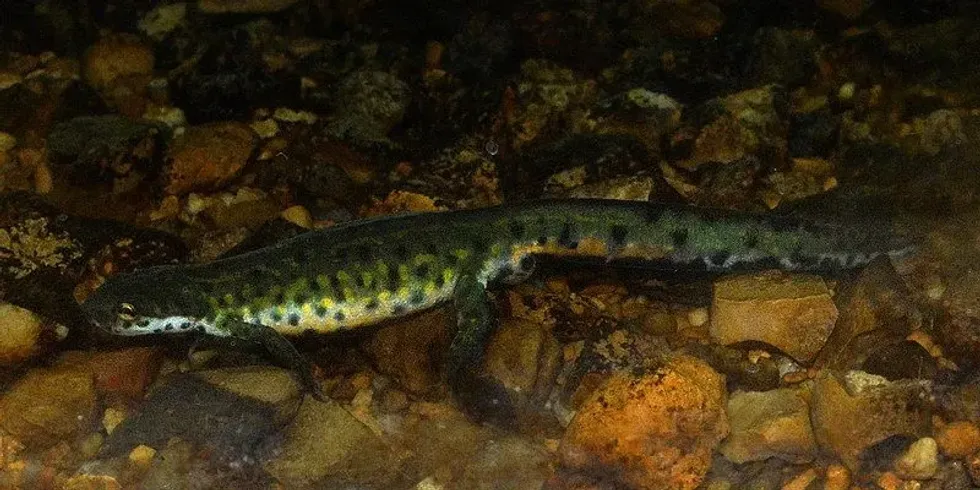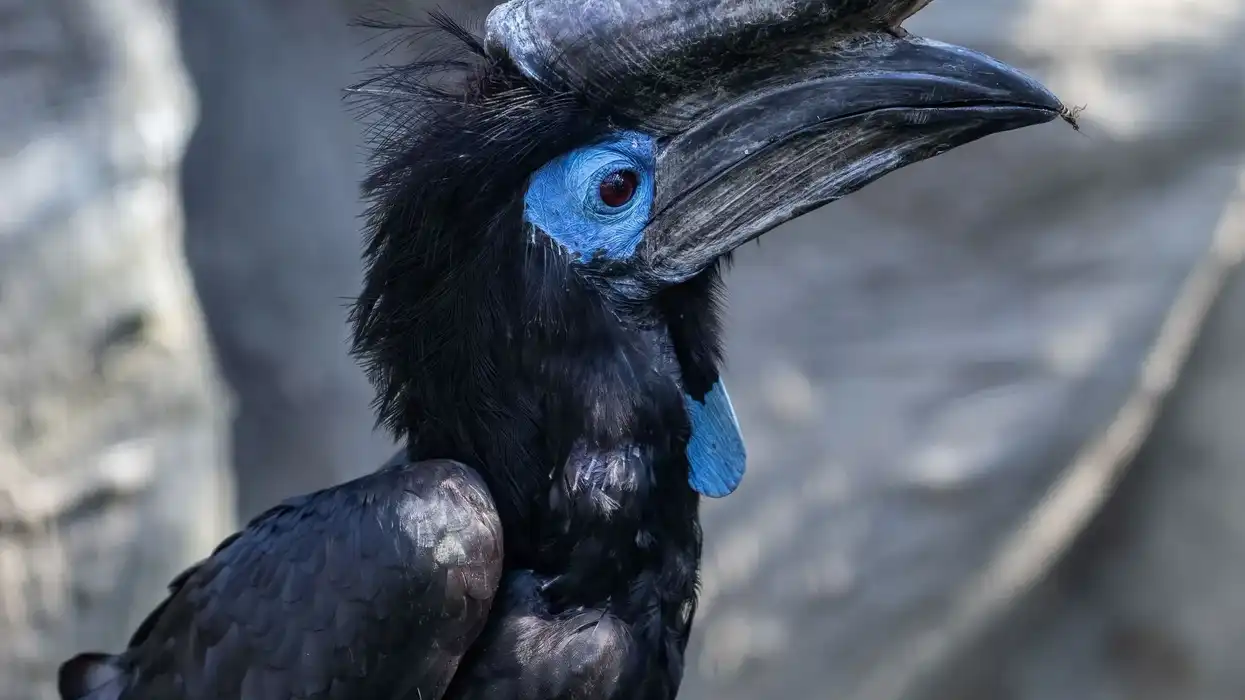The black-spotted newt (Notophthalmus meridionalis), also called Texas newt, is an aquatic newt species of the family Salamandridae. The genus Notophthalmus consists of three Newt species, striped newt, eastern newt, and black-spotted newt.
The genus name consists of two Greek elements, noton means 'back,' and ophthalmus means 'eye.' They belong to the subfamily Pluerodenilae and newts in this subfamily are semiaquatic.
The old English name for newts was efte and efeta.
As the name suggests, the black-spotted newt has several black spots on the olive green or silvery-gray body. The U.S Fish and wildlife service (FWS) studied 221 historical populations in the mid-'80s and discovered that only five remained in their native, three in Mexico and two in Texas.
The research data on the black-spotted newt suggests that these species are threatened by massive habitat loss and are decreasing in population density due to which are likely to go extinct. They are currently Endangered species.
If you like these facts on black-spotted newts, read more about the common newt and newt on Kidadl.
Black-Spotted Newt Interesting Facts
What type of animal is a black-spotted newt?
The black-spotted newt (Notophthalmus meridionalis) is an aquatic newt species of the order Urodela and phylum Chordata. This newt is a member of the true salamander and newt family. The life history of these species is not well known.
Also, the presence of an eft stage has not been determined. They camouflage well in their natural habitat. It is believed that these species either remain under debris or burrow underground in dry seasons.
What class of animal does a black-spotted newt belong to?
The black-spotted newt (Notophthalmus meridionalis) belongs to the Amphibian class of animals.
How many black-spotted newts are there in the world?
The exact number of the black-spotted newt (Notophthalmus meridionalis) population in the world is not known. However, currently only three populations in their native-one in Mexico and two in Texas.
Where does a black-spotted newt live?
Notophthalmus meridionalis occupy a range of habitats in the states of Veracruz, Tamaulipas, and San Luis Potosi in Mexico which also extends to the northeast Hidalgo and Puebla. The range of habitat also extends from southeastern Texas, along coast plain, and southern San Antonio river through the Gulf of Mexico.
The historical range of these newts extended for a hundred more miles through the Gulf coast into Mexico.
What is a black-spotted newt's habitat?
The black-spotted newt range of habitat includes shallow water, dense brush, clay soil, and ephemeral pools, permanent and temporary ponds, and ditches. They occupy heavily vegetated habitats that extend to more than 79 in (2 m) deep underwater. They also prefer a habitat with scrubs.
Who does black-spotted newt live with?
The black-spotted newt (texas newt) are mostly solitary creatures.
How long does a black-spotted newt live?
These amphibians live up to 12-15 years.
How do they reproduce?
The breeding season of black-spotted newts is throughout the year. Breeding takes place in damp places like ponds. The breeding behavior is variable and complex.
The males have pheromone-producing organs either on the head or open into the cloaca. These pheromones alter the female's hormonal state which makes her receptive. The makes develop powerful big hind limbs with horny patches on their inner surface and tail fin.
To capture the female the males use their limbs in a rapid movement. The male first deposits his sperm close to the female and pushes her over the sperm. The female then takes up the sperm into her cloaca.
The female stores the sperm in the spermathecae organ. Some of these species especially the eastern newts are highly oriented and return to their breeding habitat. Also, these species lack an eft stage commonly seen in the eastern newt species.
What is their conservation status?
The conservation status of the black-spotted newt population is Endangered. Much of the range of their habitats are lost due to clearing.
The texas parks and wildlife department has taken up conservation actions for the recovery of the habitat and population of these species. The Texas parks and wildlife department is conducting surveys on the habitats used by these species in their life history and are also calculating diversity metric for every site.
Black-Spotted Newt Fun Facts
What does a black-spotted newt look like?
The black-spotted newts have an olive green smooth-skinned body with several black and light yellow spots. They have orange to yellow colored bellies and this color extends to their sides. The tail is vertically flat and paddle-shaped.
The larvae of this species have a gray-brown dorsal color and ventrally they are pale buff. The two recognized subspecies, Texas black-spotted newt ( N. m. meridionalis) and Mexican newt (N. m. kallerti) also differ in size and shade. The texas species are bulkier and the Mexican species are dorsally dark-colored.

* Please note that this is an image of a European fire salamander. If you have an image of a Black-spotted newt please let us know at hello@kidadl.com.
How cute are they?
These newt species are slimy and are considered cute.
How do they communicate?
The black-spotted newts communicate through visual and chemical cues.
How big is a black-spotted newt?
The black-spotted newt grows 2.9-4.3 in (7.1-11 cm). These aquatic newt species are almost half the size of a great crested newt.
How fast can a black-spotted newt run?
The exact running speed of the black-spotted newt is not yet known.
How much does a black-spotted newt weigh?
The black-spotted newt weighs up to 0.022-0.11 lb (10-50 g).
What are the male and female names of the species?
There is no specific name given to male and female black-spotted newts.
What would you call a baby black-spotted newt?
There is no specific name given to the baby black-spotted newt. The baby newt is usually referred to as larva or tadpole.
What do they eat?
The black-spotted newts are carnivorous. The diet of the black-spotted newt species consists of aquatic invertebrates, insects, other amphibians, and leeches.
Are they poisonous?
Yes, these newt species are poisonous as they use toxic secretion to stay safe from predators. These species are not a threat to humans as they are shy and usually flee when they see a human. They also do not bite as such, unless extremely threatened.
Would they make a good pet?
Yes, these species would make good pets with certain precautions.
Did you know...
The Eastern newt with the scientific name Notophthalmus viridescens is the most common aquarium pet newts.
A few predators of the newt species are foxes, hedgehogs, rats, birds, and badgers. However, the main predators of these newt species are fishes.
The Tamaulipan thorn shrub occupied these newts also houses over 1,700 anima and plant species including the rare ocelot and jaguarundi.
Salamanders can regrow their limbs including their toes and tail and this allows them to survive their predators' attack.
The newts use two strategies to hunt their prey, passive snd active. The passive way is to sit and wait then ambush or is the prey moves the newt eats. The active way is to search or seek out prey.
After mating the newts get out of the water and can travel up to 0.6 mi (1 km) looking for food like beetles and worms.
The larvae will spend in few months in water after they hatch until they metamorphose into adults.
As per research, newts have the ability to endure drought for long period by burrowing into the ground.
Why is the black-spotted newt endangered?
The black-spotted newts are listed as endangered because of loss of habitat due to clearing for agriculture, cattle grazing, and development. Climate change like hurricanes and drought also threatens their habitat. Water pollution, as well as insecticide and herbicides, are dangerous to these species.
Do newts live in Texas?
The black-spotted newt species are native to south Texas and northeast Mexico.
Here at Kidadl, we have carefully created lots of interesting family-friendly animal facts for everyone to discover! Learn more about some other amphibians from our crocodile skink facts or glass frog facts pages.
You can even occupy yourself at home by coloring on one of our Black-Spotted Newt coloring pages.










